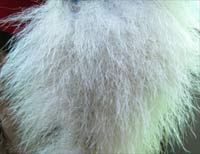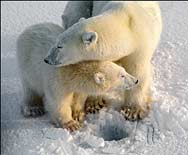Animal Facts - Polar Bear
Polar Bear Biology
Polar Bears are well suited to the Arctic ice and snow and to the different amounts of light and sunlight during the year. Their fur and skin are different to those of other bears.
 Polar Bear fur is a double coat, with a thick outer layer over softer under-fur.
Polar Bear fur is a double coat, with a thick outer layer over softer under-fur.
 The hairs in the outer layer are smooth and hollow, like tiny clear tubes.
The hairs in the outer layer are smooth and hollow, like tiny clear tubes.
They draw the sun’s heat and light down into the bear’s skin.
The long hairs stick together when wet, so water rolls off the thick outer coat, making a waterproof shield for the bear’s body.
 The skin is black, to absorb as much heat as possible.
The skin is black, to absorb as much heat as possible.
The coat looks off-white because the under-fur is pale yellowish-orange and light is reflected down into it through the hairs in the outer layer.
The skin and the layer of fat under it act like a solar panel to keep the bear warm and dry in the freezing cold.
Female Polar Bears begin to reproduce when they are 3 to 5 years old. They usually mate in late spring (April to May), and in late autumn (fall) the mother digs a tunnel and den under the snow and ice. She gives birth to two cubs in December or early January and stays in the den with the cubs until April.
 The mother stays in the den all the time, without eating or drinking.
The mother stays in the den all the time, without eating or drinking.
Her body uses the fat under her skin as food, and to make rich milk for the cubs.
When the bears leave the den, the mother protects the cubs and teaches them to survive on their own.


